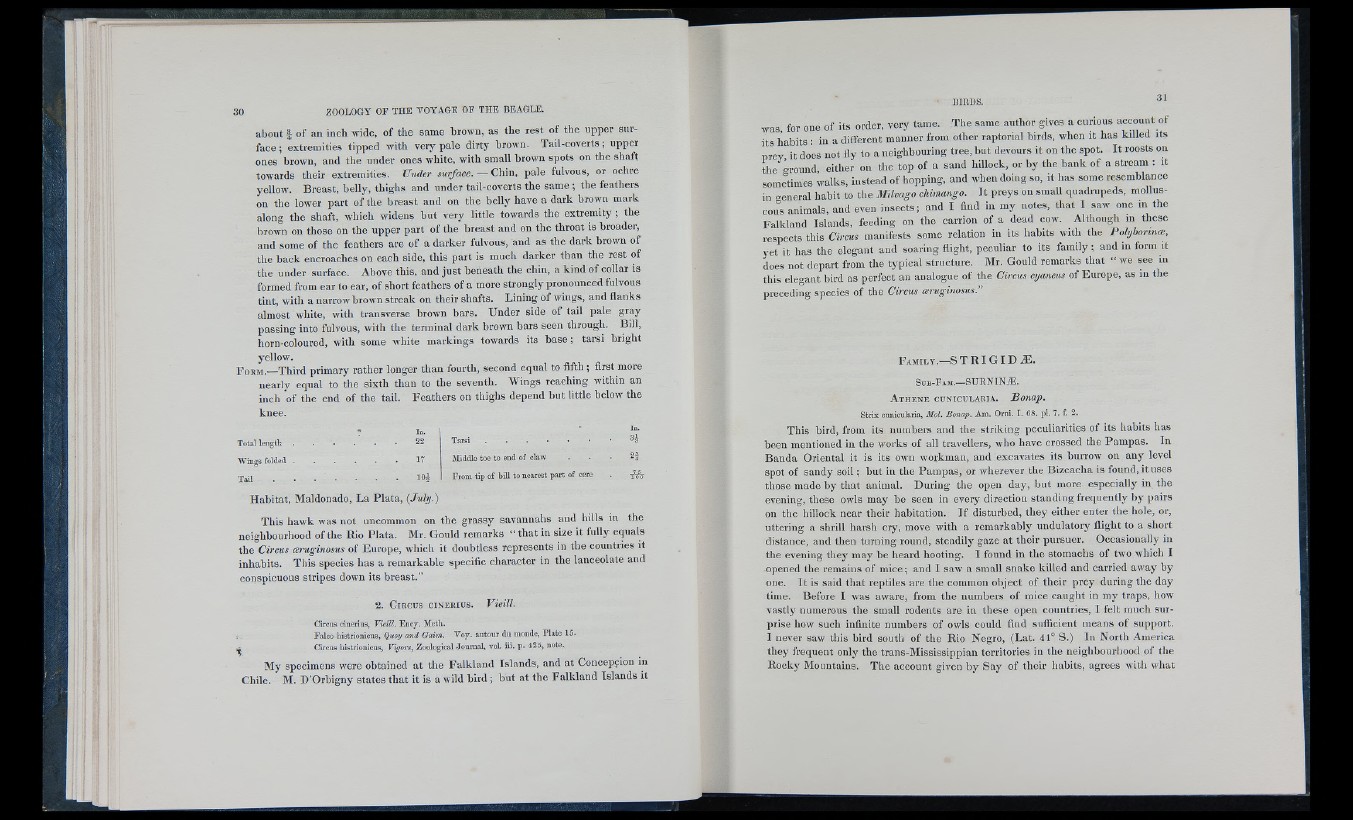
about I of an inch wide, of the same brown, as the rest of the upper surface
; extremities tipped with very pale dirty brown. Tail-coverts; upper
ones brown, and the under ones white, with small brown spots on the shaft
towards tlieir extremities. Under surface. — Chin, pale fulvous, or ochre
yellow. Breast, belly, thighs and under tail-coverts the same ; the feathers
on the lower part of the breast and on the belly have a dark brown mark
along the shaft, which widens but very little towards the extremity ; the
brown on those on the upper part of the breast and on the throat is broader,
and some of the feathers are of a darker fulvous, and as the dark brown of
the hack encroaches on each side, this part is much darker than the rest of
the under surface. Above this, and just beneath the chin, a kind of collar is
formed from ear to ear, of short feathers of a more strongly pronounced fulvous
tint, with a narrowhrown streak on their shafts. Lining of wings, and flanks
almost w’liite, with transverse brown bars. Under side of tail pale gray
passing into fulvous, with the terminal dark brown bars seen through. Bill,
horn-coloured, with some white markings towards its base; tarsi bright
yellow.
F o r m .—Third primary rather longer than fourth, second equal to fifth ; first more
nearly equal to the sixth than to the seventh. Wings reaching within an
inch of the end of the tail. Feathers on thighs depend but little below the
knee.
Tarsi . . . • • •
Middle toe to end of claw
From tip of bill to nearest part of cere
2f
Total l e n g t h ................................................... 22
Wings folded . . . . . . 17
T a i l ..............................................................lOi
Habitat, Maldonado, La Plata, {July.)
This hawk was not uncommon on the grassy savannahs and hills in the
neighbourhood of the Rio Plata. Mr. Gould remarks “ that in size it fully equals
the Circus avuginosus of Europe, which it doubtless represents in the countries it
inhabits. This species has a remarkable specific character in the lanceolate and
conspicuous stripes down its breast.”
2 . C ir c u s c i n e r i u s . Vieill.
Circus cinerius, Vieill. Ency. Meth.
: Falco histrionicus, Quoy and Qaim. Voy. autour du mondc, Plate 15.
Circus histrionicus. Vigors, Zoological Journal, vol. iii. p. 425, note.
My specimens were obtained at the Falkland Islands, and at Conception in
Chile. M. D’Orbigny states that it is a wild bird ; but at the Falkland Islands it
was for one of its order, very tame. The same author gives a curious account of
its habits : in a different manner from other raptorial birds, when it has killed its
nrev it does not fly to a neighbouring tree, but devours it on the spot. It roosts on
tlie ¿round, either on the top of a sand hillock, or by the bank of a stream ; it
sometimes walks, instead of hopping, and when doing so, it has some resemblance
in general habit to the Jlilvago chimango. It preys on small quadrupeds, molluscous
animals, and even insects; and I find in my notes, that I saw one in the
Falkland Islands, feeding on the carrion of a dead cow. Although in these
respects this Circus manifests some relation in its habits with the Polyhorinai,
yet it has the elegant and soaring flight, peculiar to its family; and in form it
does not depart from the typical structure. Mr. Gould remarks that “ we see in
this elegant bird as perfect an analogue of the Circus cyaneus of Europe, as in the
preceding species of the Circus >
F a m i l y .—S T R I G I D M.
S u b - F am.— SURNIN.®.
A t h e n e c u n i c u l a r i a . Bonap.
Sfcrix cunicularia, Mol. Bonap. Am. Orni. I. 68. pi. 7. f. 2.
This bird, from its rmmhers and the striking peculiarities of its habits has
been mentioned in the works of all travellers, who have crossed the Pampas. In
Banda Oriental it is its own workman, and excavates its burrow on any level
spot of sandy s o il; but in the Pampas, or wherever the Bizcacha is found, it uses
those made by that animal. During the open day, but more especially in the
evening, these owls may be seen in every direction standing frequently by pairs
on the hillock near their habitation. I f disturbed, they either enter the hole, or,
uttering a shrill harsh cry, move with a remarkably undulatory flight to a short
distance, and then turning round, steadily gaze at their pursuer. Occasionally in
the evening they may be heard hooting. I found in the stomachs of two which I
opened the remains of mice; and I saw a small snake killed and carried away by
one. It is said that reptiles are the common object of their prey during the day
time. Before I was aware, from the numbers of mice caught in my traps, how
vastly numerous the small rodents are in these open countries, I felt much surprise
how such infinite numbers of owls could find sufficient means of support.
I never saw this bird south of the Rio Negro, (Lat. 41° S.) In North America
they frequent only the trans-Mississippian territories in the neighbourhood of the
Rocky Mountains. The account given by Say of their habits, agrees with what